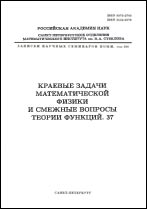|
|
Zapiski Nauchnykh Seminarov POMI, 1992, Volume 201, Pages 22–94
(Mi znsl5106)
|
 |
|
 |
On the influence of parameters determining anisotropic spaces of smooth functions on characteristics of the embedding theorems
V. P. Il'in
Abstract:
For anisotropic Sobolev and Nikol'skii–Besov spaces with
numerical integral-differential (ID) parameters (and for embedding
parameters of similar nature), we study the following things:
A) the influence of ID parameters on characteristics of conditions
determining the possible embeddings; B) the mutual influence
of ID parameters and the parameters determining properties of the
domain $G$ on the set of admissible values of embedding parameters
(AVEP). (By parameters determining properties of the domain $G$
we mean parameters describing the set $\Lambda(G)$ of all vectors
$\lambda=(\lambda_1,\dots,\lambda_n)>0$ such that $G$ satisfies the $\lambda$-corn condition;
we consider embeddings with $q\geqslant p^i$, where $q$ is the integral
embedding parameter and $p^i$'s are the corresponding parameters
of the space in question).
A). The notion of the initial matrix $A_0$ of the space in
question is introduced. This matrix is defined in terms of ID parameters
and the smallest (“initial”) values of embedding parameters
satisfying the above condition $q\geqslant p^i$. In fact $A_0$ is determined
by ID-parameters only, and, what is important, it is a $z$-matrix.
A classification of anisotropic spaces is introduced (on
the basis of a natural classification for $z$-matrices), that allows
one to answer the following questions. Which properties of ID parameters
(in other words, of the matrix $A_0$) guarantee the existence
of an embedding satisfying $q\geqslant p^i$ (see above)? If such an
embedding exist, which form assumes the existence condition, depending
on the structure and properties of $A_0$?
B). Under the assumption that the initial matrix $A_0$ of the
space in question is a non-degenerate $M$-matrix, we investigate
mutual influence of $A_0$ (i.e., ID parameters) and $\Lambda(G)$ on the
set of AVEP. In this case the existence condition for embedding
looks like $A\lambda_G^*\geqslant0$, where $\lambda_G^*\in\Lambda(G)$ is the optimal vector,
i.e. the vector such that the inequality just mentioned determines
the largest set of AVEP (for given $A_0$ and $\Lambda(G)$). The vector
$\lambda_G^*$ can be found by linear optimization methods. The following
cases can occur. а) $\lambda_G^*=\lambda_{E^n}^*$ ($\lambda_{E^n}^*$ is the optimal vector
associated with the same matrix $A_0$ and the set $\Lambda(E^n)$).
b) $\lambda_G^*\ne\lambda_{E^n}^*$. c) $\lambda_G^*$ does not exist.
In case a) the set of AVEP is the largest possible, while in case c) there is no embedding
satisfying $q\geqslant p^i$. In case b) the set of AVEP is smaller
than in case a), and here the “saturation phenomenon” with respect
to certain differential parameters occurs (this phenomenon
can be described as follows: for some spaces of functions defined
on the same domain $G$ that differ by the parameters in question
only, the sets of AVEP coincide). This implies some consequences
concerning extension of all functions in these spaces from $G$ to $E^n$.
Citation:
V. P. Il'in, “On the influence of parameters determining anisotropic spaces of smooth functions on characteristics of the embedding theorems”, Investigations on linear operators and function theory. Part 20, Zap. Nauchn. Sem. POMI, 201, Nauka, St. Petersburg, 1992, 22–94; J. Math. Sci., 78:2 (1996), 142–180
Linking options:
https://www.mathnet.ru/eng/znsl5106 https://www.mathnet.ru/eng/znsl/v201/p22
|

| Statistics & downloads: |
| Abstract page: | 118 | | Full-text PDF : | 63 |
|




 Contact us:
Contact us: Terms of Use
Terms of Use
 Registration to the website
Registration to the website Logotypes
Logotypes








 Citation in format
Citation in format 